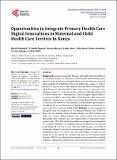Opportunities to Integrate Primary Health Care Digital Innovations in Maternal and Child Health Care Services in Kenya
Publication Date
2022-09-13Type
Article, Journalviews
downloads
Metadata
Show full item recordCitation
Matiang’I, M. , Ngunju, P. , Hetyey, A. , Odek, L. , Smet, E. , Arnoldus, M. , Opanga, Y. and Kiilu, C. (2022) Opportunities to Integrate Primary Health Care Digital Innovations in Maternal and Child Health Care Services in Kenya. Open Journal of Clinical Diagnostics, 12, 39-54. doi: 10.4236/ojcd.2022.123005.
Abstract/
Background: Adequate and quality Maternal and Child Health (MNCH) care is considered essential in reduction of maternal and child mortality. More than half of the global maternal deaths (66%) are in sub-Saharan Africa with infant mortality of 51/1000 live births in the WHO Africa region [1]. There is potential to improve access and utilization of health services through investing in Primary Health Care (PHC) digital innovations [2] especially in underserved settings [3]. In the last quarter of the year 2021 after lifting of the COVID-19 restrictions, Tekeleza project, aims to integrate digital health innovations into MNCH care within PHC settings in Kenya. The project team undertook a baseline survey in three rural counties (Kisii, Kajiado and Migori) characterized with low social-economic status to identify opportunities to leverage on the use of evidence-based digital innovations to reverse the adverse trends in Maternal and Child Health. Methods: A cross-sectional and descriptive study was conducted in 15 Community Health Units (CHUs) in Kenya that were linked to selected Primary Health Care (PHC) facilities from three rural counties. Mixed methods were used to collect data from 404 Households (HHs) selected across the sampled CHUs on Probability Proportionate to Size (PPS). The selected households were assigned unique household or respondent identifiers. The sampling frame for household surveys consisted of all women 18 - 49 years of age, who were either pregnant or in their 18 months post-delivery. From the constructed sampling frame, a simple random sampling procedure was used to select the study sample. An audit was also carried out at the selected PHC facilities and sixty-two (62) Primary Health Workers (PHCWs) including facility managers were interviewed to establish challenges affecting ICT infrastructure and sustainable financing of MNCH services. Findings: The majority of the sampled women (64.9%) were lactating at the time of the study, with 34.4% being pregnant and 0.7% both pregnant and lactating. Despite the high proportions of mothers who received Skilled Birth Attendance, discontinuity in seeking antenatal and postnatal care services was observed in all three counties. The proportion of mothers (n = 404) who reported to have attended at least one ANC was 46.8%. This was attributed to limited access to health facilities, poor staff attitude, and negative cultural practices that got exacerbated by the COVID-19 pandemic. An average of 53.2% of the respondents started attending ANC clinics much later after 12 weeks of gestation to minimize the costs and time they will spend on attending ANC clinics. It also emerged that 68.7% of the respondents had low knowledge levels of selected perinatal and infant care practices. On the making of Sexual and Reproductive Health (SRH) health-seeking decisions, 54.7% of the respondents said, it is their husbands who decide. The PHCWs expressed limited access to Continuing Professional Development (CPDs), a situation that worsened with the COVID-19 Pandemic. Notably, only 54.9% of the PHCWs reported having access to either a Smartphone or desktop at the point of service delivery. Nearly the same proportion (54.8%) has access to the internet at their workstations. Facilities reported delayed reimbursement of National Hospital Insurance Fund (NHIF) and only 54% of the women interviewed had registered in Linda mama NHIF package meant to enable them to access free maternity care. Only one county (Migori) had significant utilization of CHVs. Conclusion: There is increasing access to Skilled Birth Attendance (SBA) in rural Kenya but discontinuous pregnancy care is still a problem and it got worse during the COVID-19 pandemic. Rural PHC facilities have poor ICT infrastructure and despite the 98% rural access to a phone by women, there is limited bankable usage of handheld technology to improve health information literacy on self and infant care among women of reproductive age. Recommendations: Feasibility studies to be conducted on how to sustainably deploy Primary Health Care digital solutions to improve the quality of, access to, and Utilization of Maternal and Child Health (MNCH) services.
Publisher
Open Journal of Clinical DiagnosticsISSN
2162-5824Permalink
https://www.scirp.org/journal/paperinformation.aspx?paperid=119759https://repository.amref.ac.ke/handle/123456789/808

